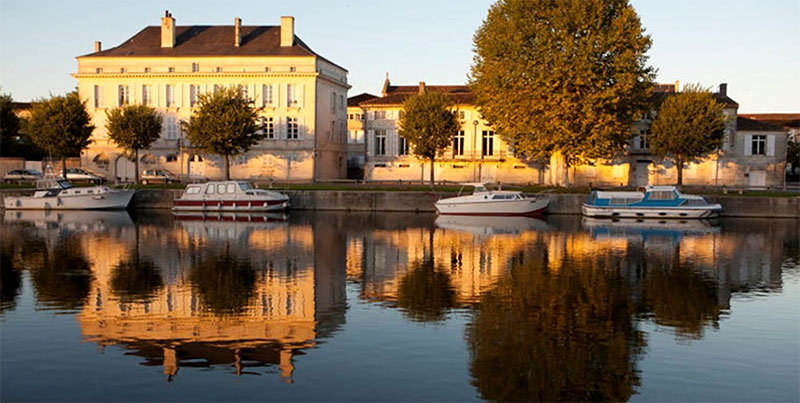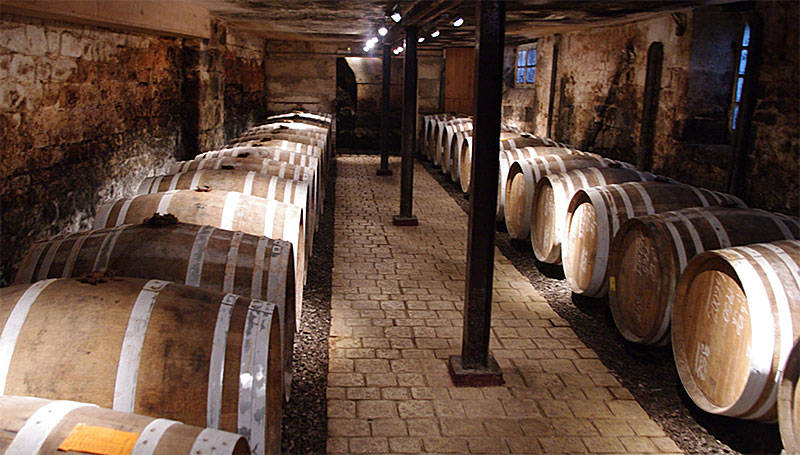
Click here for tasting notes.
H by Hine VSOP Cognac
H by Hine is a selection from Hine Cognac, a distinguished brand with a rich history which traces its origins back to the 18th century. Thomas Hine, a young Englishman from Dorset, traveled to France to learn French and the art of making cognac. He settled in the town of Jarnac, in the heart of the Cognac region, where he fell in love with and subsequently married Françoise Elisabeth Delamain, the daughter of a famous cognac négociant (a person or firm that sells or ships wine as a wholesaler).
Hine was made a partner in his father-in-law’s business, and developed a reputation for seeking out only the finest cognac. He expanded what was to become the traditional business of the Hine company: making bespoke cognacs for English wine merchants. In 1817, Thomas Hine officially took over the family business, renaming it Thomas Hine & Co.

In the 19th century, symbols became essential in the world of cognac. Thomas Hine chose the stag as an emblem, later trademarked in 1867. This symbol, combined with the Hine name, guaranteed quality and reputation. The stag, reflecting the wordplay between Hine and hind, was inspired by a white hart in Dorset, Thomas Hine’s home county, a symbol of good fortune. The reclining stag with an upright head was chosen to honor their heritage.

Located alongside the banks of the Charente River in Jarnac, the House of Hine is known for their distinct, elegant house style. The thoughtful growing of grapes in the heart of Cognac’s most desired areas is combined with the careful selection of fine-grained, lightly-toasted wood to enhance, not mask, the eau-de-vie’s flavors during the aging process. (Eau-de-vie literally translates as water of life. It is a clear, colorless fruit brandy that is produced by means of fermentation and double distillation.)
Hine sources fruit from Grande Champagne and the Petite Champagne, the two most desired premier crus in Cognac, including 284 acres of estate-owned Grande Champagne first growth vineyards in the village of Bonneuil. Limestone soils, careful tending of the vines, and precise timing for harvesting all contribute to the aromatic richness and delicate style that Hine is known for.

Photo: alcademics.com
Following fermentation, the white wine is then double distilled in copper pot stills on the lees, which are composed of yeast remnants and some of the grapes’ skin. Distilling on the lees adds extra richness and flavor, and is crucial to achieving Hine’s signature style.
Today, Cellar Master Eric Forget is at the helm, in charge of assembling Hine’s exceptional blends since 1999. Forget subscribes to a light-handed approach in the cellar and uses a careful selection of fine-grained, lightly toasted oak wood to age Hine’s eau-de-vie. These are conscious choices meant to limit the influence of the wood on the eau-de-vie and magnify the fruit flavors throughout the aging process.

New casks are used for the first eight months, and then the cognac is further matured in used barrels. Unlike many other cognac producers, no boisé, a wood extract which tries to mimic the affects of barrel ageing. is allowed, so the development is completely natural.

One of the most significant milestones in Hine’s history came in 1962 when the company was granted a Royal Warrant by Queen Elizabeth II, which recognizes Hine as the official supplier of cognac to the British royal family. Renewed every five years since, Hine remains the only cognac brand to be granted this prestigious honor
In recent years, Hine has continued to innovate while maintaining its commitment to traditional methods. The brand has expanded its portfolio to include a range of cognacs, from young VSOPs (for a cognac to be classified as a Very Superior Old Pale, the minimum age of the youngest eau-de-vie in the blend must be at least four years old) to older and more exclusive selections. The company’s cellars in Jarnac still house some of the finest and oldest cognacs in the region, reflecting centuries of expertise.
H by Hine VSOP Cognac
This elixir is a blend of 20 different eau-de-vie from the Grand Champagne and Petite Champagne crus. It is a rich amber in the glass. The nose is subtle and delicate. On the palate, under the alcohol the principle flavor is apricots, with some white-pepper spiciness in the back. The wood is understated in the Hine style, and perhaps predictably so for this relatively young cognac. Each sip ends in a medium-length finish. H by Hine is quite smooth and approachable. The ABV is 40%, usual for most spirits.
I coincidentally had a bottle of Hine Rare on hand in the liquor cabinet, so I could compare the two. The Rare has a similar color to the H, and the nose has a bit more character, although still delicate. The taste is also similar, but it struck me as rather rounder and fuller. The H by Hine retails for about $55 and the Rare for $70, so the choice would come down to their small differences in character rather than price. I lean toward the Rare, but YMMV.
I have been told that H by Hine is especially suited for mixing and cocktails. If you can afford that, then I say “party on.” However, with brandies of this quality (all cognacs are brandies; not all brandies are cognacs), Your Humble Scribe enjoys them neat, exclusively. For cocktails, I rely on my own house blend.
I haven’t been able to try the Hine 250 Years of Creation Anniversary Cognac in Putnam Decanter 1953, which sells for a mere $17,000. Pity.
Return to blog posts: https://winervana.com/blog/
